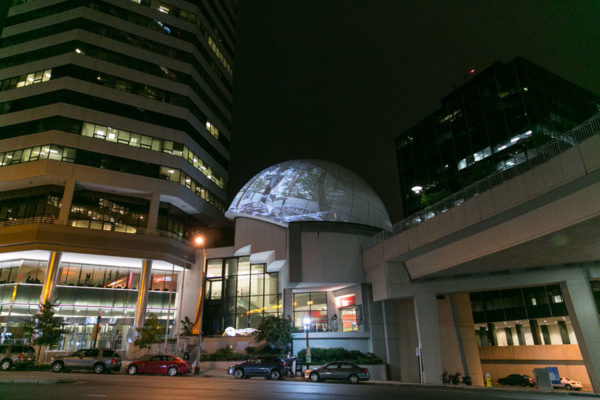Artisphere hosted its final performances this past weekend, as it prepares to close for good at the end of the month. Supporters decry the closure as the county government prioritizing penny pinching over the arts. But Artisphere’s financial losses may have been secondary to another problem: lack of community engagement.
The cultural center in Rosslyn spent more than $1 million on marketing over four and a half years, largely targeting D.C. area arts aficionados with newspaper ads. The strategy paid off with sold-out niche concerts and events, but failed to attract the loyalty of many Arlington residents who have a more casual appreciation for the arts.
 Instead of the original vision of a hub for local arts groups and a community hangout, complete with a WiFi cafe, Artisphere became more of a regional draw for one-off performances. Some 75 percent of its audience came from outside Arlington and 83 percent of its artists from outside Virginia, according to a 2014 report.
Instead of the original vision of a hub for local arts groups and a community hangout, complete with a WiFi cafe, Artisphere became more of a regional draw for one-off performances. Some 75 percent of its audience came from outside Arlington and 83 percent of its artists from outside Virginia, according to a 2014 report.
After hastily opening on the novelty date of 10/10/10, before an executive director or a marketing director could even be hired, Artisphere’s finances proved to be a fiasco. Wildly over-optimistic expectations gave way to the realization that the center would only make a quarter of its projected visitor revenue in the first year. That, in turn, sparked community criticism, set off backtracking by policymakers and led to a series of changes that watered down community participation.
The cafe closed, Artisphere focused more on event rentals and a popular local theater company was booted out.
It didn’t help that Artisphere’s multitude of performance venues were small and, as officials figured out after opening, couldn’t host simultaneous events due to noise bleed.
The relative lack of participation from taxpaying Arlington residents and artists, in the end, may have been Artisphere’s biggest downfall. When Artisphere hit the chopping block, few residents showed up at County Board meetings to speak in its defense.
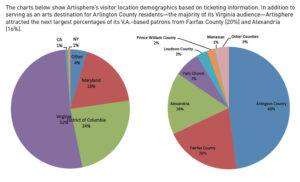 “That’s exactly part of the issue,” said retiring Arlington County Manager Barbara Donnellan, in a May interview. “At some levels, it wasn’t reaching our community in such a way that won their support.”
“That’s exactly part of the issue,” said retiring Arlington County Manager Barbara Donnellan, in a May interview. “At some levels, it wasn’t reaching our community in such a way that won their support.”
(An online petition to save Artisphere gathered nearly the same number of signatures as a recent petition to save a large oak tree on N. Nottingham Street.)
Donnellan and the County Board faced criticism in the local arts world for the decision, with letters to the editor, the chair of the Arlington Commission for the Arts and even a Washington City Paper cover story implying that the Board was naive in closing Artisphere just because it was losing money.
“Artisphere’s closure is symptomatic of a much larger political view of culture in which the arts are important to community building, but funding them is not,” the City Paper wrote. It along with the Washington Post were the beneficiaries of 55 percent of Artisphere’s marketing budget.
But there was more that went into the decision to close than just dollars and cents. Arlington County Board Chair Mary Hynes said Artisphere was “able to create some wonderful shows” after “‘we got some of the right programming people in place,” but “there was a struggle in terms of what type of place [Artisphere] was going to be.”
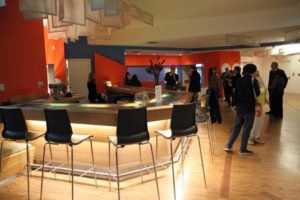 “Within our Cultural Affairs department there was a real desire to be cutting edge and to fill a niche they perceived in the D.C. arts scene,” Hynes said. “So people on the way up” were booked, but “those are people who who are developing an audience, not those who have an audience.”
“Within our Cultural Affairs department there was a real desire to be cutting edge and to fill a niche they perceived in the D.C. arts scene,” Hynes said. “So people on the way up” were booked, but “those are people who who are developing an audience, not those who have an audience.”
There was discussion of hosting “community Saturdays” — with performances from school groups and other community-driven activities — “where we get people familiar with coming here because their kid is performing here.”
“But that didn’t fit with the image of what people thought of as [Artisphere],” Hynes said. “So I do think that audience was pretty constrained in terms of all of Arlington.”
“In the end we collectively didn’t see as much of an opportunity for full community participation here than we see in some other things we do,” Hynes said of the decision to close Artisphere and send about half of its budget back into other arts programming around Arlington. “When a locality is putting its tax money into helping the production of art, we have some obligation to consider how we give as many people in our community as possible the opportunity to consume good art.”
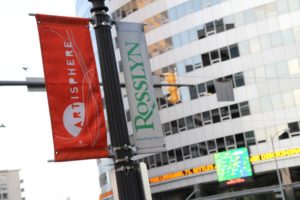 Artisphere’s regional focus was a carefully thought-out feature, not a bug. In addition to its artistic goals, Artisphere was also conceived as an economic development tool for Rosslyn. The Rosslyn BID contributed $1 million to the center’s startup costs and another $300,000 per year to its operating budget for that purpose. Artisphere’s FY 2014 annual report highlighted that it’s “a regional draw… underscoring Artisphere’s role as an economic driver for its community.”
Artisphere’s regional focus was a carefully thought-out feature, not a bug. In addition to its artistic goals, Artisphere was also conceived as an economic development tool for Rosslyn. The Rosslyn BID contributed $1 million to the center’s startup costs and another $300,000 per year to its operating budget for that purpose. Artisphere’s FY 2014 annual report highlighted that it’s “a regional draw… underscoring Artisphere’s role as an economic driver for its community.”
Barry Halvorson, Artisphere’s Director of Communications and Marketing, defended the decision to focus on regional arts consumers and unique programming instead of a more mainstream or more community-focused strategy.
“We are trying to serve a community of arts-goers and we’ve been very successful in doing that and we’ve gotten a lot of attention in the press,” Halvorson told ARLnow.com in April. “If you go to the Washington Post or the Washington City Paper, there’s just a ton of coverage that we’ve gotten on our programming in large part because it’s so novel in this market.”
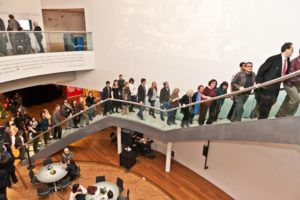 “I think maybe the readership of ARLnow might be a bit different than maybe the arts section of the Washington Post,” Halvorson continued. “We’re trying to go after the people who are reading the arts section. That might be the reason why ARLnow commenters are not seeing our materials. Because we are out there, editorially and advertising-wise. We’re reaching the arts market here.”
“I think maybe the readership of ARLnow might be a bit different than maybe the arts section of the Washington Post,” Halvorson continued. “We’re trying to go after the people who are reading the arts section. That might be the reason why ARLnow commenters are not seeing our materials. Because we are out there, editorially and advertising-wise. We’re reaching the arts market here.”
Halvorson said Artisphere was an artistic success, with critically acclaimed programming and shows averaging 70-75 percent audience capacity, above industry averages, since the center’s inception. Most of its spring shows were sold out.
“That is a misperception in the community that our events are not well attended,” he said. “All throughout our nearly five year history [events] have been very well attended. If anything right now we’re riding this great wave where we’re really firing on full cylinders.”
Halvorson was emphatic that the focus on Artisphere’s finances by the media missed the point.
“When you really look at the editorial about Artisphere, how many times has the phrase ‘the money-losing Artisphere’ been used?” he asked. “You wouldn’t refer to the Kennedy Center as the ‘money-losing Kennedy Center,’ when in fact it is losing money. Every arts organization in town is in fact a money-losing venture. That’s just the nature of being a non-profit. Every arts organization has a form of subsidy, including donations from private donating. In the case of the Artisphere, that’s taxpayer funding.”
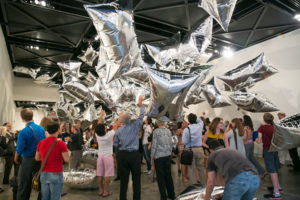 “I have to be brutally honest that your publication has not been terribly helpful in that regard,” Halvorson added. “When you’re talking about an arts organization, there are many different measures of success,” including attendance and artistic impact.
“I have to be brutally honest that your publication has not been terribly helpful in that regard,” Halvorson added. “When you’re talking about an arts organization, there are many different measures of success,” including attendance and artistic impact.
(A total of 288 ARLnow.com articles include a reference to Artisphere. Most were previews of events, exhibits or concerts taking place at the facility.)
Halvorson said Artisphere would have been in better shape had its space — provided rent-free by building owner Monday Properties — been smaller and more efficient. Electricity, heating and air conditioning in the 63,000 square foot facility alone cost about $1 million per year.
“This has been a very expensive building to operate,” he said. “The building is 25 years old. Escalators, elevators are breaking down and expensive. It’s been somewhat of a minor miracle that we’ve been able to keep this building running at the level it’s at.”
Donnellan said the decision to recommend closing Artisphere as “a very, very difficult choice,” and she only made the decision after “months” of discussions with Artisphere staff, Arlington Economic Development officials and Rosslyn property owners, about possible ways to gain a broader audience.
“You have to make decisions that are long term sustainable,” she said. “Artisphere was not gaining money and not sustaining itself. But the main thing was that it had lost the support of the community and the Board and it became very difficult to argue its long term sustainability in these economic times. It wasn’t getting a lot of support… it had never achieved the foot traffic needed.”
 “Honestly I do believe that it could have been successful,” Donnellan said. “But given the economic times of Rosslyn, with the amount of construction going on down there and the economy in and of itself, it was just not an entity that was going to grow at a pace where it was something that we would have said ‘wow, this is something that we have to keep going.'”
“Honestly I do believe that it could have been successful,” Donnellan said. “But given the economic times of Rosslyn, with the amount of construction going on down there and the economy in and of itself, it was just not an entity that was going to grow at a pace where it was something that we would have said ‘wow, this is something that we have to keep going.'”
Could Artisphere have gained more attendees and local support with more marketing and more community visibility? It’s unclear.
Artisphere spent only about $200,000 per year on marketing. Over the course of almost five years, most of that went to regional media organizations: more than $400,000 to the Washington Post, $170,000 to the Washington City Paper, $71,000 to WJLA/Newschannel 8, $26,000 to BrightestYoungThings.com, $19,000 to the Washington Examiner, $17,000 to Washington Parent magazine.
(You can view sorted and unsorted PDF copies of Artisphere’s line item marketing expenses, obtained by ARLnow.com under the Freedom of Information Act.)
Halvorson said Artisphere made the most of what it had.
“Our [annual] marketing budget is $200,000 for 140 artistic programs,” he said. “I challenge you to find an arts organization with a lower per program budget. If the question is, if I were to do this over again, would I have gone for a broader more scattershot approach versus a more targeted approach, no I would not.”


